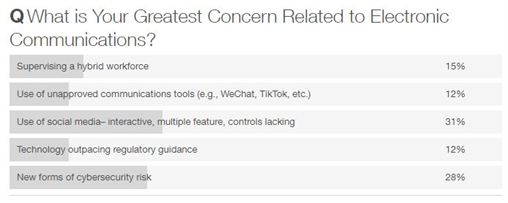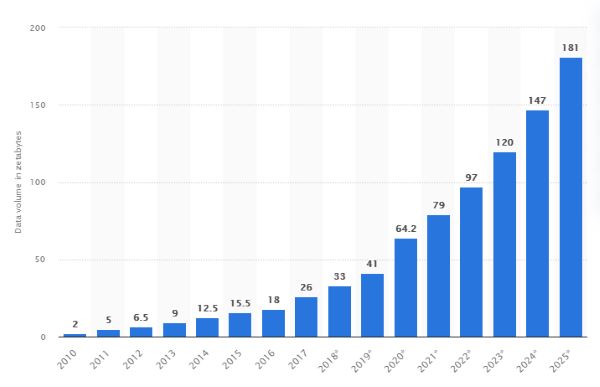Financial Services Push to Keep Pace as Digital Communications Hit the Fast Lane
The evolution of electronic communications has been an ongoing journey over the last few decades. New channels for communication were introduced, every so often, like exits on the highway. Text messaging next right, social media to your left. Over time, many regulated organizations had been able to compliantly adopt new channels for business use. Then, the pandemic took hold and it was pedal to the metal.
Collaboration, conferencing and chat platforms went from supplementing the workplace to replacing it. And a variety of new features continue to appear, like bots and AI, without so much as a pit stop. For traditional industries like financial services, these changes have happened so fast they’ve been hard to keep up with.
The digital journey has been a unique experience from several vantage points:
- Demographic: digital natives, born with mobile devices in hand and accustomed to engaging on TikTok, Instagram and Reddit, expect to interact with financial services (retail investing, retirement planning, etc.) through digital apps
- Industrial: financial services firms are rethinking how business can be performed through new means of communication and modes of collaboration. For a few in this category, it also represents the opportunity to capitalize on a relatively untapped segment of the market
- Cybersecurity & risk: for those with nefarious intentions, the digital shift signifies a move to where the action is now happening, and an opportunity to hatch the latest scheme before security and compliance controls can catch up
- Regulatory: for regulators, it has disrupted how the rules of the road are defined, acknowledging that many guidelines are no longer suited for purpose and are in drastic need of modernization
Each of these factors plays an important part in contextualizing the current state of business in financial services. They indicate what firms should be considering as they update their strategies and compliance technology.
Are we there yet?
Demographic and market behaviors continue to evolve. Firms are now racing to add broker and advisory staff to pursue retail investors — a market they hadn’t been actively targeting — for what they view as one of the largest opportunities of 2022.
More firms are also recognizing that social media is a critical asset for engagement. TikTok — now the world’s most downloaded app — and Instagram are the preferred platforms for Gen-Z investors looking for financial advice. In fact, TikTok and other social platforms are now visiting college campuses, recruiting customers and prospective employees, viewing it as a huge underserved market of active traders.
From the perspective of financial firms, this is a good thing. According to the most recent Social Advisor from Putnam Investments, 94% of financial advisors have seen success on social platforms, and 84% expect that changes to communication practices will remain post-pandemic.
Caution: regulatory crossing
On the other hand:
- Financial regulators are handing out massive fines for failure to provide oversight of social media activities of their employees
- FINRA announced it will conduct spot exams on options trading, a preferred vehicle for retail investors
- SEC begins enforcement of schemes involving meme stocks
- SEC is reviewing social media posts for potential fraud
- SEC is requesting comment on digital engagement practices, including the use of gamification
In response to a webinar poll asking their greatest concern related to electronic communications, the use of social media by employees was number one.

"What is your greatest concern related to electronic communications?" *Source: Smarsh
Blind corners, proceed with caution
More firms are trying to pick up the pace of adopting modern channels, but innovation is outpacing them. Smaller firms or those with fewer resources are turning to individual point solutions per channel for compliance. Or, at minimum, capturing only chat from multifaceted, interactive tools like Microsoft Teams or Zoom. And if registered reps are using public-facing social media platforms like Instagram, Reddit or TikTok to conduct business, most firms aren’t yet equipped to track those communications.
An additional unique challenge with hybrid work is what employees may be doing in their spare time on unsupported platforms. The Roaring Kitty case is now just one of more than 40 regulatory actions this year related to outside business activities (OBA) – with consequences for the representative and their firm. In some cases, personal liability may even fall directly onto the CCO.
As communications sources multiply and the volume and velocity of data continue to increase, financial firms should be equipping their organization with compliance technology that can meet not just today’s, but tomorrow’s needs. They must be able to capture, archive and monitor new channels at scale. Capabilities such as natural language processing and machine learning will be key to preserving and examining growing, complex datasets.
Firms should be stepping up their third-party due diligence and selecting vendors that can appropriately meet their security, privacy and regulatory requirements. The right technology investments can ensure the ability to enable communications and mitigate risk.

Volume of data/information created, captured, copied and consumed worldwide from 2010 to 2025 (forecast) *Source: Statista
Navigation: Waze or a folded map?
Ultimately, there is no disputing that technology has outpaced the traditional rules of the road. And now it is time to modernize the books and records rules. Even SEC 17a-4, which was implemented in 2003 and outlines requirements for data retention, indexing and accessibility for companies that deal in the trade or brokering of financial securities (stocks, bonds, futures, etc.) does little to address current realities like persistent chats, blockchain technology, or natural language processing.
There is some dispute, though, as to which electronic communications meet the spirit of current recordkeeping definitions for written communications (does that include virtual whiteboards or Zoom video recordings? Modernizing the rules will provide clarity for firms and allow them to be more efficient, transparent, and prepared for the future.)
Where are you in your digital journey?
Hybrid work, new social communications tools, and the limited reach of existing supervisory controls have left many firms wondering where to begin in their assessment of risk. That's why we designed an easy-to-use Hybrid Workforce Risk Assessment tool. This DIY scorecard will help firms identify their level of communications risk across several key factors, including infrastructure, policies and procedures, and employee awareness. Get your copy here.
Share this post!
Smarsh Blog
Our internal subject matter experts and our network of external industry experts are featured with insights into the technology and industry trends that affect your electronic communications compliance initiatives. Sign up to benefit from their deep understanding, tips and best practices regarding how your company can manage compliance risk while unlocking the business value of your communications data.




Subscribe to the Smarsh Blog Digest
Subscribe to receive a monthly digest of articles exploring regulatory updates, news, trends and best practices in electronic communications capture and archiving.
Smarsh handles information you submit to Smarsh in accordance with its Privacy Policy. By clicking "submit", you consent to Smarsh processing your information and storing it in accordance with the Privacy Policy and agree to receive communications from Smarsh and its third-party partners regarding products and services that may be of interest to you. You may withdraw your consent at any time by emailing privacy@smarsh.com.
FOLLOW US